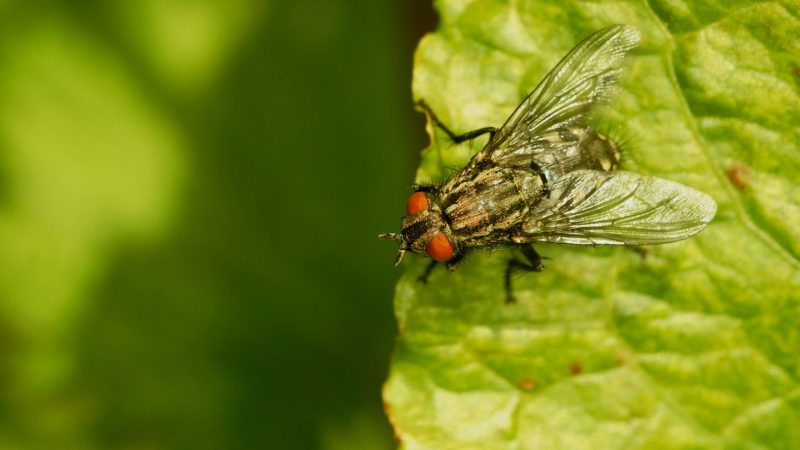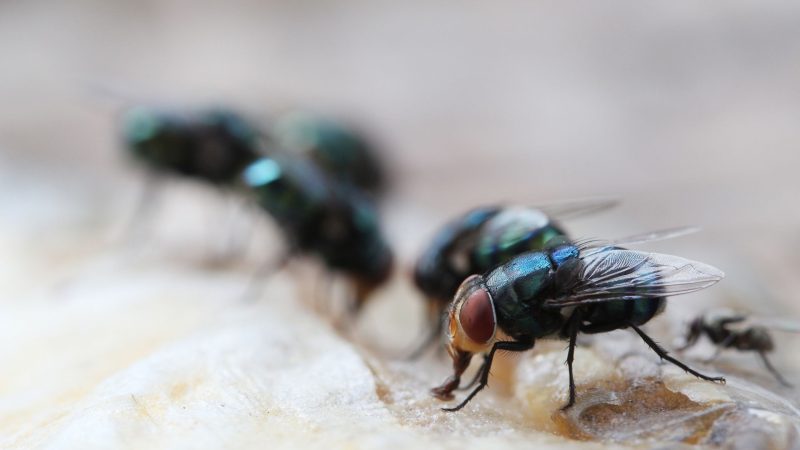Flesh flies are sometimes mistaken for house flies because they have similar colors and markings. As expected, they are also pesky pests and can transmit some diseases. Needless to say, flies are also parasites to other small insects and can be found almost everywhere. This is why you should get rid of them.
How to get rid of flesh flies? The best way to get rid of flesh flies is by maintaining cleanliness inside homes and surroundings. This includes removing all their potential source of food and areas where females lay eggs, such as dead animals and decaying or rotting organic matter. Fly swatters and traps also work.
Just like most fly species, flesh flies rarely bite humans, but it doesn’t mean they are not dangerous. In fact, both adults and larvae can cause severe infestation indoors and outdoors. They can help forensic specialists a lot in investigating a crime. Nevertheless, it’s not an excuse for not killing them.
What Are Flesh Flies?

Flesh flies are flies that belong to the Sarcophagidae family in the Order of insects called Diptera. These tiny, creepy creatures are always present shortly after an animal has died. Nonetheless, they are also dubbed as crime scene insects. Flesh flies arrive first at a crime scene, earlier than police investigators.
There are about 2,500 species of flesh flies around the world, and 327 of them can be found in the United States. The red-tailed flesh fly (Sarcophaga pernix) is one of the most common species in North America. But because they are tropical insects, they are more common in the southern part of the United States.
What Does a Flesh Fly Look Like?
At first glance, a flesh fly looks like an ordinary housefly. For comparison, flesh flies have three dark stripes on top of their gray thorax (area behind their head), while house flies have four of these dark stripes. They also have a light and dark gray checkerboard pattern on their abdomen, wherein the tip is often red.
Depending on the species, fleshfly larvae (maggots) are between 10 and 22 mm (3/8 and 7/8 in) long once they are fully grown. They are usually white to yellowish and have pointed heads. Adult flesh flies have black bodies and can be from 10 to 13 mm long, which are smaller than house flies.
Life Cycle of a Flesh Fly
Flesh flies undergo complete metamorphosis during their life cycle. They have four developmental stages – egg, larva, pupa, and adult.
Egg Stage
Females usually lay eggs on garbage, trash receptacle, dead animals, or any decaying organic matter. Some species may also deposit live larvae or eggs in open wounds.
Flesh fly eggs are usually from 0.5 to 3.5 mm (27/64 to 35/64 in) long and 0.12 to 0.8 mm (13/32 to 7/16 in) wide. Unlike most fly species, females are ovoviviparous and are engaged in larviposition. This means that their eggs hatch within their bodies, and females deposit them on feces and decomposing matter.
Larval Stage
The flesh fly larvae undergo three developmental stages or instars. A single female can have as many as 325 larvae.
Pupal Stage
Once mature maggots are ready to enter the pupal stage, they leave their host and move to a more suitable location, such as under the soil. Here, they go into a hibernation-like state for several weeks.
Adult Stage
Depending on the species, these pupae will emerge as adults after 10 – 14 days. Afterward, their life cycle will be repeated. As weird as it seems, male flesh flies cannot recognize gender. Therefore, they sometimes mate with other males, even with the dead. Also, they can mate with the same female multiple times.
Related: How to Get Rid of Horse Flies | Long-Term Results!
How Fast Do Flesh Flies Reproduce?

Female flesh flies incubate their eggs for about 13 days before they go into larviposition. Flesh fly larvae complete their three instar stages within five to seven days, depending on the temperature. Under laboratory conditions, it takes about 23 days to complete their life cycle, from first instar larvae to adults.
How Long Do Flesh Flies Live?
Flesh flies live very short, with a lifespan of only 15 – 25 days, depending on their species. However, multiple generations of flesh flies are being produced every year. Just like house flies, they will die in 48 hours without food and water. Nonetheless, they usually get juice from feeding on feces and dead animals.
Where Do Flesh Flies Live?

Flesh flies are mostly found in urban and rural communities, and different species are distributed throughout the world. Although they prefer living in warm tropical areas, these nuisance pests usually inhabit places that are not suitable for most fly species. Fortunately, they rarely live in restaurants, houses, and offices.
Nonetheless, flesh flies are known for being synanthropic insects. This means they live in close association with humans. However, they depend on the live or dead tissues of animals as well as humans before they can complete their life cycle, hence their name. For this reason, flesh flies are commonly used in laboratories.
What Do Flesh Flies Eat?
As their name implies, flesh flies eat flesh. They feed primarily on a wide variety of hosts, including animal carcasses and feces, human cadavers and waste, and even fresh open wounds. Similarly, fleshfly maggots eat excrement from humans and animals, insect larvae, and any kind of decaying organic matter.
What Are Flesh Flies Attracted To?
Flesh flies are very much attracted to all rotting organic materials, including recently deceased animals and humans. Most fleshfly maggots are also internal parasites to other insects, particularly those that are in the Order of Orthoptera. This includes grasshoppers, crickets and locusts, and their close relatives.
What Causes Flesh Flies in the House?
Flesh flies enter houses because they smell the strong odors of decaying animals. These disgusting insects swarm inside homes with dead bodies of both animals and humans, especially in their early stages of decomposition. They can easily pass through very small openings such as wall cracks and damaged windows.
Do Flesh Flies Carry Disease?

Flesh flies carry diseases. Most species carry leprosy bacilli, (also known as Mycobacterium leprae), which causes the infectious disease called leprosy, commonly known as “Hansen’s disease.” They can also transmit intestinal pseudomyiasis and have been reported to cause Myiasis in people and animals.
How Serious Are Flesh Flies?
Flesh flies are serious when it comes to posing health risks to humans. Hansen’s disease (Leprosy) is rare and doesn’t spread easily between people during casual contact such as sitting together, sitting next to each other, and shaking hands. However, leprosy can lead people to blindness and paralysis if left untreated.
Likewise, Myiasis mostly occurs in tropical and subtropical areas. Although not infectious, flesh flies can easily transmit this disease to humans by depositing their eggs near or on an open wound. On the other hand, people can have intestinal pseudomyiasis from the accidental eating of flesh flies eggs, and larvae.
How Can I Tell if I Have a Flesh Fly Problem?
Owners of homes and businesses may experience problems with flesh flies. If flesh flies suddenly start to arrive inside, there may be a dead rat or other pest animal trapped in a chimney, wall hole, or crawl space.
Live larvae are produced by the bugs in organic waste like animal corpses and rubbish. It is a major problem to see flesh fly maggots fall from ceiling tiles or to find them in storage spaces.
How Do Flesh Flies Get Inside Homes and Businesses?
Open doors and ripped screens are two common entry points for flesh flies into homes and apartments. Uncovered trashcans, compost piles, and pet waste left outside can all attract bugs because of their strong aromas and signs of decay. A flesh fly may fly near decks looking for crumbs and will also seek for sweets.
How to Get Rid of Flesh Flies Naturally?
As mentioned above, flesh flies are attracted to open wounds, dead animals, or any decaying matter. Fortunately, you don’t need to buy expensive pesticides just to get rid of these pesky pests. Below are some simple things you can do to get rid of them in the most natural ways:
- Dispose of dead animals at once. This includes rats, mice, raccoons, insects, and your pet dog or cat.
- Check for possible animal feces. They can be in your yard, under your furniture, or attic. Remove them at once and sanitize the area thoroughly.
- Vacuum the area where you see them. There might be some eggs or larvae left behind. Don’t forget to throw away the vacuum bag.
- Use fly swatters and fly traps. They are most effective as immediate solutions in their early stage of infestation. However, fly swatters can be messy.
- Cover open wounds. If you or any household member has an open wound, cover it well with a bandage and dispose of the used bandage properly.
- Seal all the gaps around your house. You can use foam, a caulking gun, or weather-stripping tape. Replace damaged screens on doors and windows.
- If possible, use automatic doors. These doors are mechanically designed to close automatically, in case you forgot to close them.
- Secure your trash cans. Always close their lids and empty them once they are already full. Clean them properly and remove the foul odor.
How to Trap Flesh Flies?
Just like other fly species, flesh flies are also attracted to lights. But unlike house flies and fruit flies, they are less attracted to fruits and sweet foods. So, if you cannot find where they are coming from, you can install fly light traps such as Gardner FlyWeb Classic Fly Light . Here are some tips for using them effectively:
- Hang the light trap about 6 feet (1.82 meters) above the floor and around 15 feet (4.5 meters) away from your windows and door.
- Install them in dark areas where flesh flies cannot see them from the outside.
- Remove dead flesh flies from the flytrap and replace the bulb annually.
Alternatively, you can use fly trap ribbons such as the Raid Window Fly Trap (2 Pack) . This product is non-toxic, inexpensive, and can easily be hung indoors or outdoors. Each pack has 4 plastic traps, which means there are a total of 8 traps for each package. Raid is very famous when it comes to insect repellents.
Related: What Is the Purpose of Flies? | Information and Facts
How to Prevent a Fly Infestation?
Garbage collection should occur once or twice weekly in warm climates. This makes it certain that the fly life cycle will be disrupted. Garbage cans should also be cleaned often. To get rid of organic matter or decaying fruits and vegetables, make it a habit of cleaning it down once a week.
Poop attracts flies. If your pets are free to roam the yard and eliminate wherever they like, you should clean up and dispose of the waste. You have two options for disposing of dog waste: either use disposable poop bags or set up a system similar to a septic system.
Maintain good condition on all of your home’s screens. If you frequently eat outside, think about getting mesh food filters.
List of Sources
Public Health Vectors and Pests: Flesh Fly. KwaZulu-Natal Department of Health.
Showman, A., Connelly, C. (2019). Red-Tailed Flesh Fly, Sarcophaga Haemorrhoidalis (Fallén) (Insecta: Diptera: Sarcophagidae). University of Florida.
Flesh Flies. Utah State University.
Hansen’s Disease (Leprosy). (2017). Centers for Disease Control and Prevention.
Indoor Flies and Their Control. Texas A&M AgriLife Extension.
- How to Get Rid of Copperheads | Practical Guide - August 27, 2023
- How to Get Rid of Corn Snakes | What Makes Them Aggressive? - August 27, 2023
- How to Get Rid of Alligators | Safety Measures and Removal Methods - July 16, 2023

